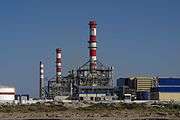Energy in Tunisia
The energy sector in Tunisia includes all production, processing and transit of energy consumption in this country.


Oil and gas upstream sector
Tunisia is a small producer of oil and natural gas. Oil production began in 1966, at 118,000 barrels/day in 1980, and reached 63,000 barrels in 2015.[1] The country is a net importer from the year 2000 onwards. The country's main deposit is also the first to be discovered. : El Borma, in 1964, on the Tunisian-Algerian border.[2]
The Gulf of Gabes offers offshore production centered on the Ashtart deposit, put into production in 1974 by, at the time, Elf Aquitaine.[3] Gas production increased in the 2000s thanks to two offshore deposits, Miskar (producing from 2006) and Hasdrubal (2009). These two deposits are now experiencing a natural decline in production.
The Zarat deposit is scheduled to come into service around 2020 and boost national production somewhat.[4]
Downstream sector
Refining
The only refinery in the country, managed by the Tunisian Company of Refining Industries, is located in Bizerte. Its capacity is 34,000 barrels / day, which is a much lower production than the country's consumption, which therefore imports refined products, diesel chiefly. Refined petroleum is essentially imported too.[5]
Transit of natural gas
The Trans-Mediterranean Pipeline, one of the gas pipelines that allow the export of Algerian gas to Italy, crosses Tunisian territory. It operates since 1983.[6] In return for the crossing of its territory, Tunisia is entitled to 5.625% of the gas, in kind or in money, in accordance with a treaty of 1977.[7] The capacity of the Trans-Mediterranean Pipeline is increased gradually, increasing also the Tunisian quota which, added to the national production and gas bought directly to Algeria, ensures the consumption of the country.
Consumption
According to the Energy Information Administration, Tunisia's consumption in 2015 was 98,000 barrels/day.[8] · [5]
Natural gas consumption is in the order of 6.5 km3, of which more than half is imported via the Trans-Mediterranean Pipeline. 70% of the gas is used for the production of electricity.
Electrical sector and renewable energies
The International Energy Agency[5] reports for 2014 an electricity production of 19 TWh, compared to 10.5 TWh in the year 2000. The Tunisian Company of Electricity and Gas (STEG), a public company, ensures the three quarters of production. The network operates at 50 Hertz and the voltage at the domestic level is 230 Volts.
Virtually all Tunisian electricity (18 TWh) is produced by thermal power plants burning natural gas, the largest of which is in Sousse. Wind energy is the second largest source of electricity in the country; a capacity of 305 MW has been installed in a few years.[1]
The British company TuNur Ltd defends a major project in solar energy, which would consist in building in stages 4,500 MW of thermodynamic solar power plants in southern Tunisia, and export electricity to Malta first, then Italy and finally France.[9]
Tunisia aims to generate 30% of its electricity from renewable sources by 2030.[10] The country currently gets only 3% to 6% of its electricity from renewable sources, mostly from wind and hydro.[11][12] Solar energy capacity is at 35 megawatts (MW).[12]
In 2011, Tunisia emitted 33 metric tons of carbon dioxide equivalent (MtCO₂e) in greenhouse gasses. The country aims to reduce its carbon intensity by 13% in 2030, compared to 2010 levels.[13]
Nuclear
Tunisia was evaluating the possibility of building a 600 MWe nuclear plant. In December 2006, a cooperation agreement on peaceful use of nuclear energy was signed with France, focused on nuclear power and desalination.[14][15] It was supposed to account for 20% of Tunisia's power needs.[16]
In June 2015, Tunisia signed a MOU with Russia. Rosatom said "For the first time in the history of Russian-Tunisian relations, this document has laid the legal foundation for interaction between Russia and Tunisia in nuclear energy, covering a broad range of topics," Rostom said these include : support in the development of nuclear energy infrastructure in Tunisia; fundamental and applied research; the design, construction and operation of nuclear power plants and research reactors; the production and use of radioisotopes in industry, medicine and agriculture; radioactive waste management; the training of specialists in nuclear physics and nuclear energy [17]
The plan is for nuclear power to replace gas. Nuclear could generate 13% of power by 2023, under 2015 projections.[18]
References
- "BP Statistical Review of World Energy June 2016" (pdf).
- "Arab Maghreb Union".
- "Présentation".
- "Tunisie – Énergie : le P-dg de l'ETAP réclame des mesures spécifiques en matière d'emploi dans le secteur du pétrole" (in French).
- "Statistics".
- "Trans-Mediterranean Natural Gas Pipeline".
- "Algerian Gas to Europe: The Transmed Pipeline and Early Spanish Gas Import Projects" (pdf).
- "Tunisia".
- "Après l'échec de Désertec, un nouveau projet solaire dans le Sahara pour alimenter l'Europe".
- Macola, Ilaria Grasso (2020-01-16). "Engie and Nareva partner up to build solar power plant in Tunisia". Power Technology | Energy News and Market Analysis. Retrieved 2020-06-22.
- Ngounou, Boris (2019-12-20). "Tunisia: Scatec Solar to build 3 solar PV power plants of 360 MW capacity". Afrik 21. Retrieved 2020-06-22.
- Mandela, Dominic (2020-01-28). "120MW solar pv 'Gafsa plant' to be constructed in Tunisia". Construction Review Online. Retrieved 2020-06-22.
- "Greenhouse Gas Emissions in Tunisia" (PDF). October 2015. Retrieved June 22, 2020.
- "Emerging Nuclear Energy Countries". World Nuclear Association. April 2009. Retrieved 2009-04-22.
- "Archived copy". Archived from the original on 2016-07-04. Retrieved 2019-12-04.CS1 maint: archived copy as title (link)
- http://uk.reuters.com/article/2009/04/23/idUKLN941296
- http://www.world-nuclear-news.org/NP-Russia-and-Tunisia-sign-nuclear-MOU-02061503.html
- https://www.iaea.org/NuclearPower/Downloadable/Meetings/2015/2015-10-27-10-30-NIDS2/22_Tunisia.pdf